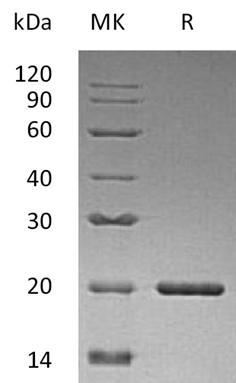#C100, Recombinant Human SHH
Recombinant Human Sonic Hedgehog is produced by our E.coli expression system and the target gene encoding Cys24-Gly197 is expressed.
- Accession: Q15465
- Known As: Sonic Hedgehog Protein; SHH; HHG-1
- Mol Mass: 19.69 KDa
- APMol Mass: 19 KDa, reducing conditions
- Formulation Description: Lyophilized from a 0.2 μm filtered solution of 20mM PB, 100mM NaCl, 1mM DTT, pH 7.5.
- Endotoxin: Less than 0.001 ng/µg (0.01 EU/µg) as determined by LAL test.
- Purity:

Greater than 95% as determined by reducing SDS-PAGE.
- Reconstitution
Always centrifuge tubes before opening.Do not mix by vortex or pipetting.
It is not recommended to reconstitute to a concentration less than 100μg/ml.
Dissolve the lyophilized protein in distilled water.
Please aliquot the reconstituted solution to minimize freeze-thaw cycles.
- Storage
Lyophilized protein should be stored at < -20°C, though stable at room temperature for 3 weeks.
Reconstituted protein solution can be stored at 4-7°C for 2-7 days.
Aliquots of reconstituted samples are stable at < -20°C for 3 months.
Reconstituted protein solution can be stored at 4-7°C for 2-7 days.
Aliquots of reconstituted samples are stable at < -20°C for 3 months.
- Shipping
The product is shipped at ambient temperature.
Upon receipt, store it immediately at the temperature listed below.
- Background
Sonic Hedgehog Homolog (SHH) belongs to a three-protein family called hedgehog. The other two family members are Indian Hedgehog (IHH) and Desert Hedgehog (DHH). Hedgehog proteins are key signaling molecules in embryonic development. SHH is expressed in various embryonic tissues and plays critical roles in regulating the patterning of many systems, such as limbs and brain. SHH also plays an important role in adult, including the division of adult stem cells and the development of certain cancers and other diseases. Human SHH is expressed as a 45kDa precursor, and undergoes a series of processing during secretion. After the removal of the signal peptide, a protease within the C-terminal domain catalyzes the cleavage of SHH into a 20 kDa N-terminal signaling domain (SHH-N) and a 25 kDa C-terminal domain (SHH-C). SHH-N has the “all signaling” capability. SHH-N binds to the 12 pass transmembrane protein Patched (Ptc) on cell surface, which releases the repression of the activity of Smoothened (Smo), a G-protein coupled receptor, by Ptc.
For Research or Manufacturing Use Only, Not for Use in Diagnostic or Therapeutic Procedures.

